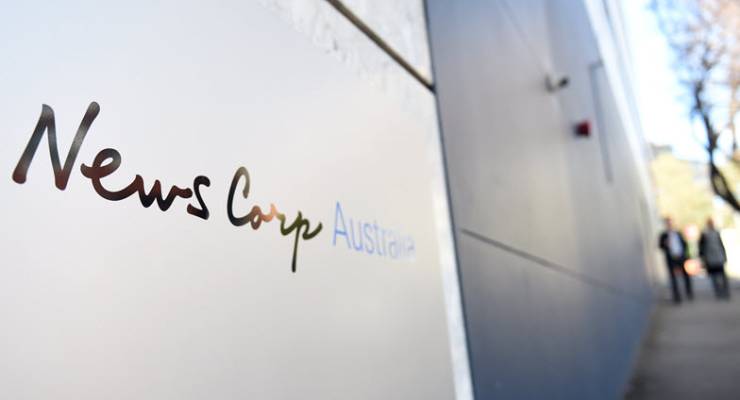
New Corp seems to be struggling to reach that critical cross-over point where more income flows from reader revenues than from advertising. At least, that’s the conclusion we can draw from the financial figures and public statements released over the last week.
This is critical because the advertising model that sustained news media in the 20th century is irretrievably broken. To survive, commercial news media need to rely on people actually giving them money so that they can employ the journalists to generate news.
Yet News Corp’s 10K filings with the US Securities and Exchange Commission (released last Tuesday) show that reader revenues — subscriptions and sales — are essentially flat-lining: US$2.16 billion in 2015, US$2.11 in 2016, to US$2.01 in the 2017 financial year.
It’s an increasing proportion of revenues. But only because, at the same time, advertising revenues continue to slide: from US$3.16 in 2015, to US$2.81 in 2016 to US$2.61 in the 2017 financial year. That’s not the “cross-over” that will solve the problem.
These are global data: they include the company’s UK papers (The Sun and The Times) and its US operations (mainly The Wall Street Journal). And most of this revenue — both advertising and subscriptions — comes from print.
For the first time, the 10K report also gave us an insight into the scale of the print decline. Usually, News Corp (like Fairfax) report aggregate movements in advertising revenues, so that print losses are offset, in part at least, by digital increases.
This year, the 10K tells us that print advertising in Australia is down about A$130 million, offset in part by a A$58 million part-year boost from the purchase of regional newspapers in Queensland and northern NSW in late 2016. This brings their total Australian revenues to about A$1.6 billion. Last Monday, before the 10K was released, I estimated a figure of A$1.4 billion.
At the same time, the company has relied on its own internal data to talk up its digital subscription revenues. In a world exclusive, The Australian last Monday broke the news that the paper was in surplus for the first time since the 2008 financial crisis. According to the report, this was off the back of great journalism. Oh, and A$25 million in digital revenues and a high-end real estate insert.
This fleshed out the statement by CFO Susan Panuccio to analysts the Friday before that the News Corp Australia mastheads had 360,000 digital subscribers. The Australian report indicates about 100,000 of these are for the broadsheet. Applying The Australian’s multiplier indicates that News Corp’s digital subscription momentum is delivering about A$100 million towards the A$1.6 billion of the company’s Australian revenues.
This breakdown illustrates the challenge for News Corp in Australia. Digital subscriptions tend to be stronger in the market for what we used to describe as “broadsheets” than for tabloids. This is a function of demographics. The “broadsheets” like The Australian or The SMH or The Age, have always targeted higher income groups, the so-called A-B demographic. And they’re stronger for national than for regional voices. Yet, other than The Australian, News’ Australian papers tend to the regional and the tabloid.
News has also said that its employees should be getting ready for another A$40 million in cost cuts. Those employees know that the low hanging fruit is long gone and, to mix cost-cut metaphors, cuts are hitting the bone. Again, this is an unprecedented transparency for the company.
These figures coupled with the greater transparency over the future of print lead us to ask: What’s News Corp up to? As Crikey reported last week, all the publicly available material tells us that the income curve is only a matter of years from crashing through the fixed cost floor of newspaper production. Relying on print is no longer viable. Now it looks like News Corp has stopped trying to convince themselves of the opposite.
The one indicator of their thinking is the announcement last Thursday, that News Corp was merging Foxtel (owned 50-50 with Telstra) and the fully owned Fox Sports, to create a new company 65% owned by News Corp and consolidated in News Corp’s accounts. This company will be floated, allowing either parent to draw down their equity in the new company if they wanted to exchange for cash.
This will be another conundrum for the regulators and is a further reason for the Senate to leave the proposed media law reform on hold (assuming Section 44 of the Constitution leaves enough senators around to make a decision).
As far as News Corp is concerned, this will leave a news media company in the odd position of having most of its revenues and costs locked up internally in its News and Information Services segment, while it draws its profits from majority-owned subsidiaries in real estate and cable services.








Fellow Australians well done and keep it up. Do our great nation a big favour when it comes to Rupert Murdoch products, …do not support or subscribe to NewsCrap publications and Foxtel. Shitty products are not worth it and deserve to be totally ignored. Without public support, advertisers also take away their support of shitty products.
Unfortunately the LNP government has now taken to GIFTING yes folks GIFTING tax payer monies to Foxtel. It is presumed in the hope of garnering support from Rupert Murdoch come next election. The LNP has run out of believable slogans to fool the Australian voting sheeples.
They have only themselves to blame. For years now I have not bought any Murdoch press because the copy is so biased. And it’s not even clever propaganda either. It’s offensively crude. I won’t pay for lies. It’s hard to even find the facts inside the positions they take.
Great news. About time that these biased publications close down to lack of interest.